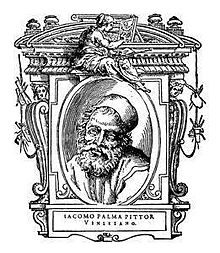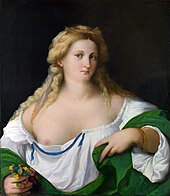Jacopo Palma (the old man)
Jacopo Palma (* around 1480 in Serina Alta, today Serina near Bergamo ; † July 30, 1528 in Venice ), often also called Jacopo Palma il Vecchio ("the old man"), was a Northern Italian painter of the Venetian school .
Jacopo Palma il Giovane ("the younger") was his great-nephew .
life and work
Little reliable is known about the life of Palma. But from his works, over fifty of which have survived, it is clear that he trained in Venice under the influence of Giovanni Bellini , Cima da Congeliano and Carpaccio , that he later changed his style after his contemporaries Tizian and Giorgione and finally in the in the last period of his career developed to full artistic freedom and independence.
With Tizian and Giorgione he describes the high point of Venetian painting during its heyday. He painted altarpieces and religious paintings for palaces and family chapels, mostly depicting the Madonna with the child and several saints, sometimes also with the donors in a quiet get-together (called sacra conversazione , sacred entertainment) as well as portraits, individual figures and study heads.
His main work, at the same time one of the most perfect and magnificent creations in painting, is Saint Barbara, painted around 1515 (Venice, Santa Maria Formosa ). His first period includes a Madonna and Child (Berlin, Museum), the Madonna with saints and angels making music in Zerman near Treviso, and Saint Peter with six saints (Venice, Academy).
The second period includes Saint Barbara, Adam and Eve (Braunschweig, Herzog Anton Ulrich-Museum ), Christ and the adulteress (Rome, Capitol), the Visitation of the Virgin Mary (Vienna, Imperial Gallery), the Adoration of the Shepherds (Paris, Louvre ), the Madonna with Peter (Rome, Palazzo Colonna ), the Madonna under the tree with four saints (Vienna, imperial gallery) and the holy family with Jerome and Catherine (Naples, museum)
The last period includes the Madonna with Saints Lucia and George (Vicenza, San Stefano), the Adoration of the Magi (Milan, Pinacoteca di Brera ) and Jacob and Rahel (Dresden, gallery).
The most beautiful of his portraits and individual figures are owned by the imperial galleries in Vienna (including the so-called Violante and a Lucrezia), the Dresden gallery (a resting Venus and the three sisters), the Palazzo Sciarra in Rome (under the name "la bella il Tiziano") ) and the Berlin Museum.
Palma was the painter who knew how to portray the beauty of Venetian women most brilliantly, especially in his last period when he let the local colors blur in a delicate light.
literature
- Barbara Maria Savy: NEGRETTI (Negreti, Nigreti), Jacopo, detto Palma il Vecchio. In: Raffaele Romanelli (ed.): Dizionario Biografico degli Italiani (DBI). Volume 78: Natta – Nurra. Istituto della Enciclopedia Italiana, Rome 2013.
- Max von Boehn : Giorgione and Palma Vecchio (= artist monographs. Volume 94). Velhagen & Klasing, Bielefeld and Leipzig 1908.
- Adolf Rosenberg : Jacopo Palma il Vecchio (= Velhagen & Klasings monthly books . Volume 19 , 1904/1905, part 3). 1904, OCLC 48576919 , p. 285-304 .
- Palma Vecchio - Venetian school (= Masters in art. A series of illustrated monographs. Volume 6 ). Bates & Guild, Boston 1905, OCLC 368668582 , pp. 28 ff . ( Text archive - Internet Archive ).
Web links
- Works by Jacopo Palma (the old man) at Zeno.org .
- Literature by and about Jacopo Palma in the catalog of the German National Library
| personal data | |
|---|---|
| SURNAME | Palma, Jacopo |
| ALTERNATIVE NAMES | Palma, Jacopo (il Vecchio); Negreti, Jacopo d'Antonio; Nigreti, Jacopo d'Antonio |
| BRIEF DESCRIPTION | Italian painter |
| DATE OF BIRTH | around 1480 |
| PLACE OF BIRTH | Serina |
| DATE OF DEATH | July 30, 1528 |
| Place of death | Venice |









